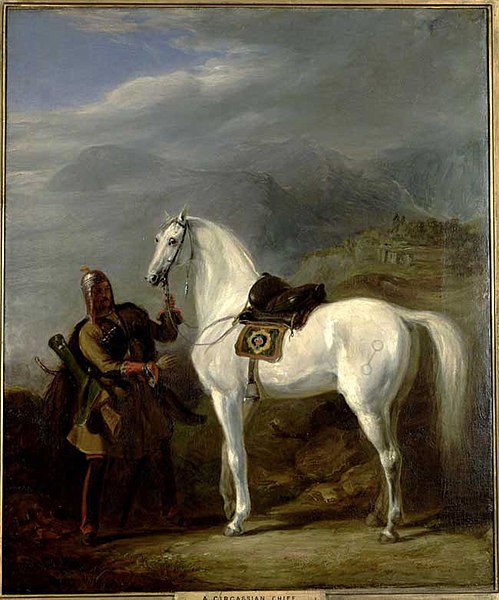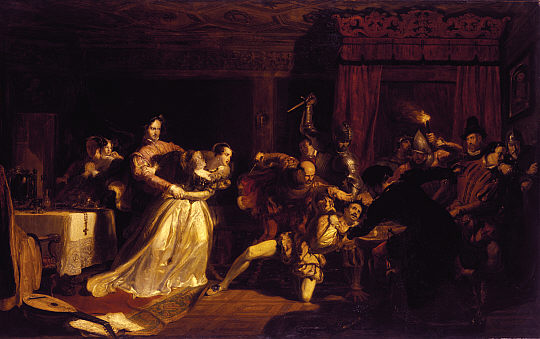William Allan
- Birth Date:
- 00.00.1782
- Death date:
- 22.02.1850
- Length of life:
- 68
- Days since birth:
- 88501
- Years since birth:
- 242
- Days since death:
- 63611
- Years since death:
- 174
- Extra names:
- William Allan, Вильям Аллан, Сэр Вильям Аллан, Sir William Allan
- Categories:
- Painter
- Cemetery:
- Set cemetery
Sir William Allan (1782 – 22 February 1850) was a distinguished Scottish historical painter known for his scenes of Russian life. He became president of the Royal Scottish Academy and was made a Royal Academician.
Life and work
Allan was born in Edinburgh, the son of William Allan Snr., macer - a humble officer of the Court of Session. He was educated at the High School, Edinburgh, under William Nicol (1744?-1797), the companion of Robert Burns. Showing an aptitude for art, he was apprenticed to a coach-painter, and studied under John Graham at the Trustees' Academy, with David Wilkie, John Burnet, and Alexander George Fraser.
After a few years he came to London, and entered the schools of the Royal Academy. His first exhibited picture was a "Gipsy Boy with an Ass" (1803), in the style of John Opie. In 1805 he travelled, by ship, to Russia, but was wrecked at Memel, where he raised funds for the remaining journey by painting portraits of the Dutch consul and others. He then proceeded overland to St. Petersburg, passing through a great portion of the Russian army on its way to Austerlitz. At the Russian capital he found friends, including Sir Alexander Crichton, physician to the imperial family. Having learned Russian, he travelled in the interior of the country, and spent several years in the Ukraine, making excursions to Turkey, Tartary, and elsewhere, studying the culture of Cossacks, Circassians, and Tartars, and collecting arms and armour. In 1809 a picture by him of "Russian Peasants keeping their Holiday" was exhibited at the Royal Academy. His wish to return home in 1812 had to be postponed due to the French invasion of Russia, many of the horrors of which he witnessed first-hand.
Allan was able to return to Edinburgh in 1814, and, in 1815, his picture of "Circassian Captives" attracted notice at the Royal Academy, though it did not find a purchaser; however Sir Walter Scott, John Wilson (1785–1854) and his brother James (1795–1856), John Lockhart, and others, raised a lottery for it, with 100 subscribers at £10 10s. each, and the picture was won by the Earl of Wemyss. Allan remained in Edinburgh, and though his pictures (including "Tartar Robbers dividing their Spoil") did not find purchasers amongst his countrymen, some of them were bought by the Grand Duke Nicholas when he visited Edinburgh. Allan afterwards painted some scenes from Scottish history suggested by the novels of Sir Walter Scott, such as "Death of Archbishop Sharpe" and "Knox admonishing Mary Queen of Scots" (exhibited in 1823 and engraved by John Burnet). His "Death of the Regent Murray" (exhibited 1825) was purchased by the Duke of Bedford for 800 guineas, and gained the artist his election as an associate of the Royal Academy. In 1826 he was appointed master of the Trustees' School, Edinburgh, an office which he held till a few years before his death.

![]() Circassian Chief (1843)
Circassian Chief (1843)
Soon afterwards Allan's health gave way, and he was threatened with blindness. To recuperate he went to Rome, and, after spending a winter there, proceeded to Naples, Constantinople, Asia Minor, and Greece. In 1826 he exhibited "Auld Robin Gray" and in 1829 the "Prophet Jonah". In 1830 he returned to Edinburgh restored to health. His picture of the"Slave Market, Constantinople", was purchased by Alexander Hill, the publisher, and ‘Byron in a Fisherman's Hut after swimming the Hellespont’ (exhibited 1831) by R. Nasmyth, who also bought Allan's portraits of Burns and Sir Walter Scott, which were engraved by John Burnet.
In 1834 he visited Spain and Morocco. In 1835 he was elected a Royal Academician, and in 1838, on the death of Sir George Watson, was made president of the Royal Scottish Academy. In 1841 he went to St. Petersburg, and in the same year succeeded Wilkie as limner to the queen in Scotland, an office which was, as usual, followed (in 1842) by a knighthood.
In 1843 Sir William exhibited the "Battle of Waterloo from the English side", which was purchased by the Duke of Wellington, and the next year went again to St. Petersburg, where he painted, for the Czar, "Peter the Great teaching his Subjects the Art of Shipbuilding". The last large work which he finished was a second view of the battle of Waterloo, this time from the French side. It was exhibited at Westminster Hall in 1846, in competition for the decorations of the Houses of Parliament, but was unsuccessful. He visited Germany and France in 1847.
At the time of his death in Edinburgh, on 23 February 1850, Sir William was engaged on a large picture of the "Battle of Bannockburn".
Works
- Russian Peasants keeping their Holiday (1809)
- Bashkirs (1814, Hermitage)
- Frontier Guard (1814, Hermitage)
- The Sale of Circassian Captives to a Turkish Bashaw (1816)
- Tartar Robbers dividing Spoil ( 1817, Tate Gallery)

![]() The Murder of David Rizzio (1833) depicts the killing of Queen Mary's secretary David Rizzio in her presence, an event which took place at Holyroodhouse in 1566
The Murder of David Rizzio (1833) depicts the killing of Queen Mary's secretary David Rizzio in her presence, an event which took place at Holyroodhouse in 1566
- John Knox admonishing Mary, Queen of Scots (1823)
- The Regent Murray shot by Hamilton of Bothwellhaugh (1825, Woburn Abbey)
- The Black Dwarf (1827, National Gallery of Scotland)
- Lord Byron in a Turkish Fisherman's House after swimming across the Hellespont (1831)
- Slave Market (1838, National Gallery of Scotland)
- The Signing of the National Covenant in Greyfriars Kirkyard (Edinburgh City Arts Centre)
- The Recovery of the stolen Child (1841, Aberdeen, Art Gallery)
- Battle of Prestonpans (1842, Private Collection)
- Peter the Great teaching his Subjects the Art of Shipbuilding (1845, formerly in the Winter Palace of the Hermitage, now lost)
- Waterloo, June 18, 1815 (1843, His Grace Arthur Wellesley, 8th Duke of Wellington, Apsley House)
- The Duke of Wellington - en route to Quatre Bras (1844, Private Collection)
- The Battle of Waterloo (1845, Royal Military Academy Sandhurst)
- Battle of Bannockburn (Royal Scottish Academy, on loan to the Wallace Monument, Stirling)
- Heroism and Humanity (Robert the Bruce with soldiers) (1840 Kelvingrove Museum)
Source: wikipedia.org
No places

No relations set
No events set

